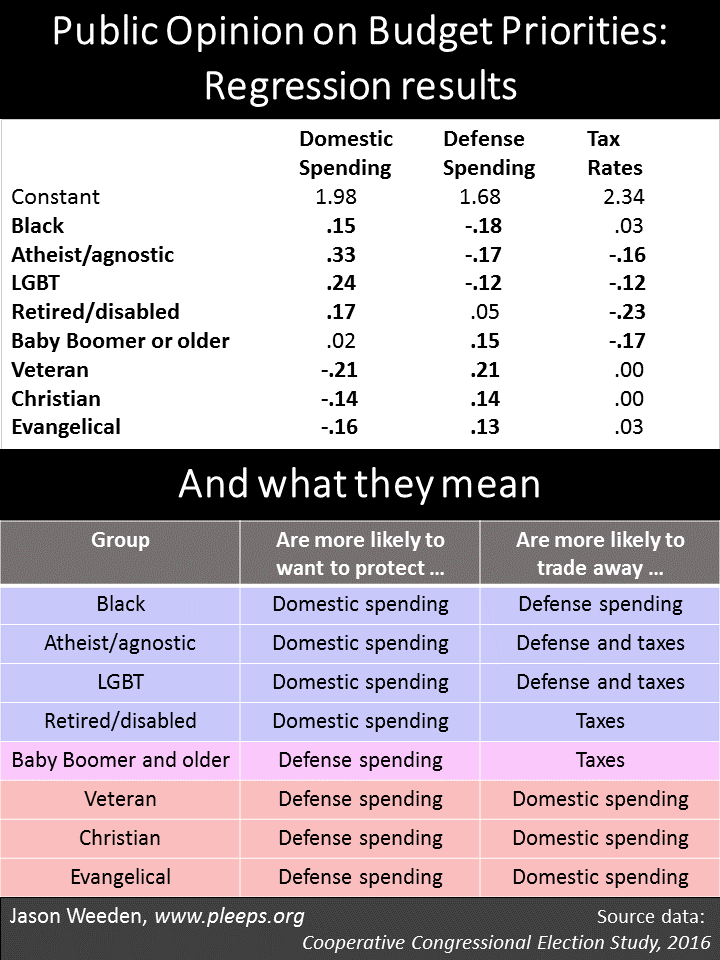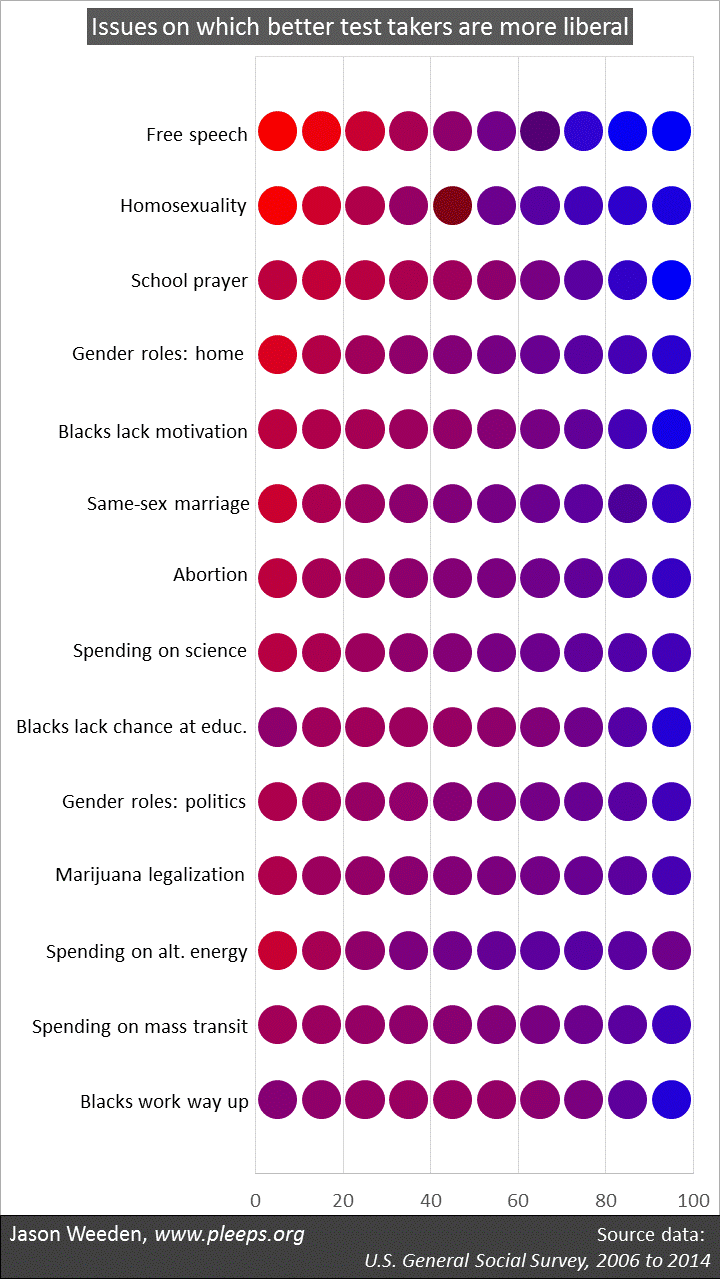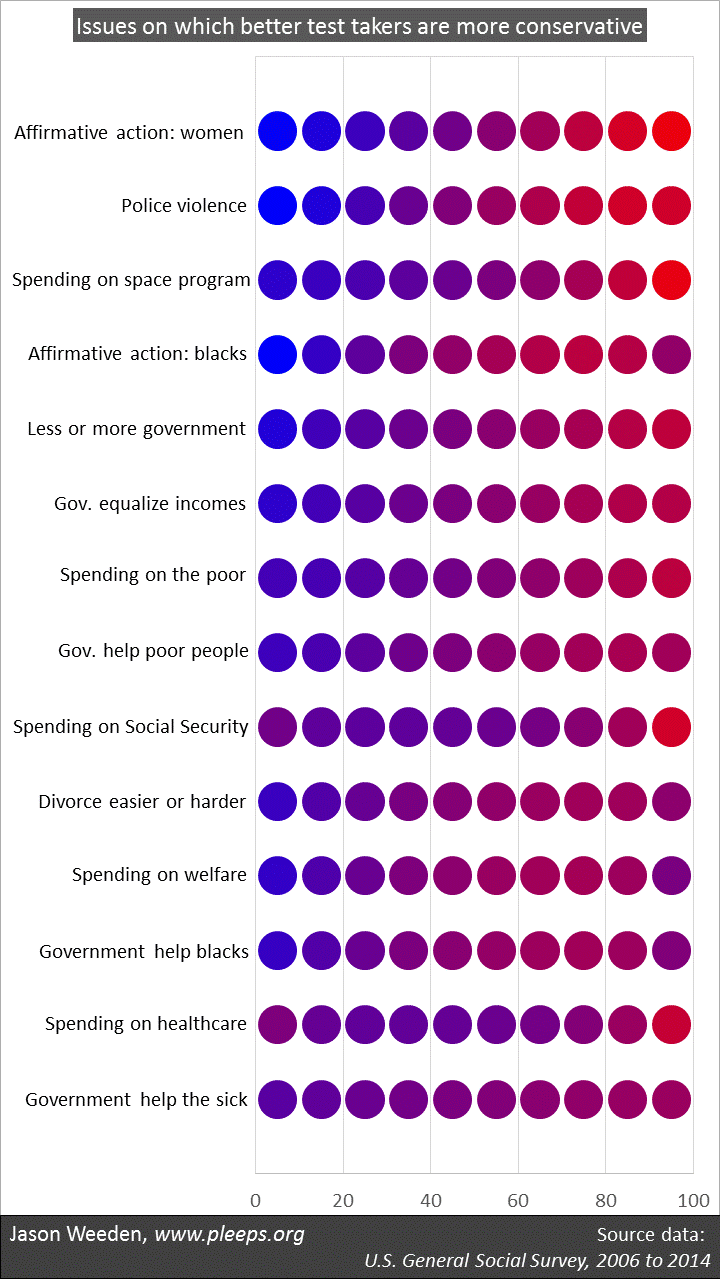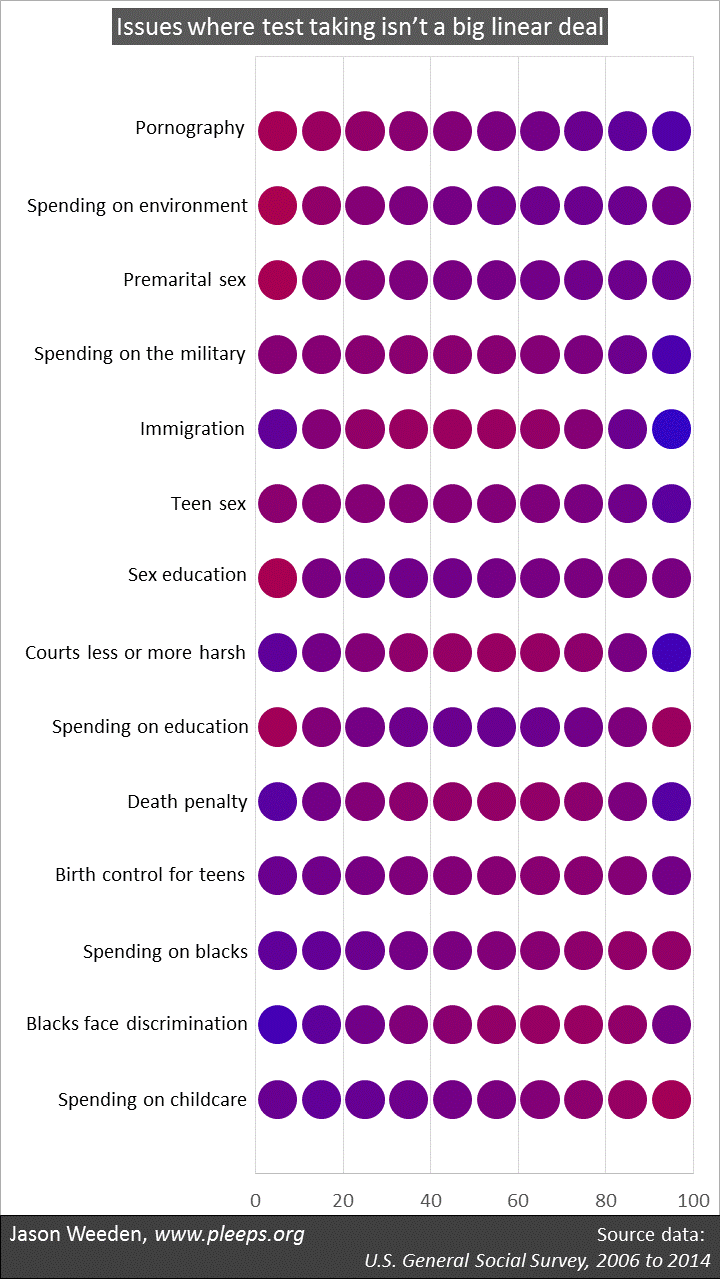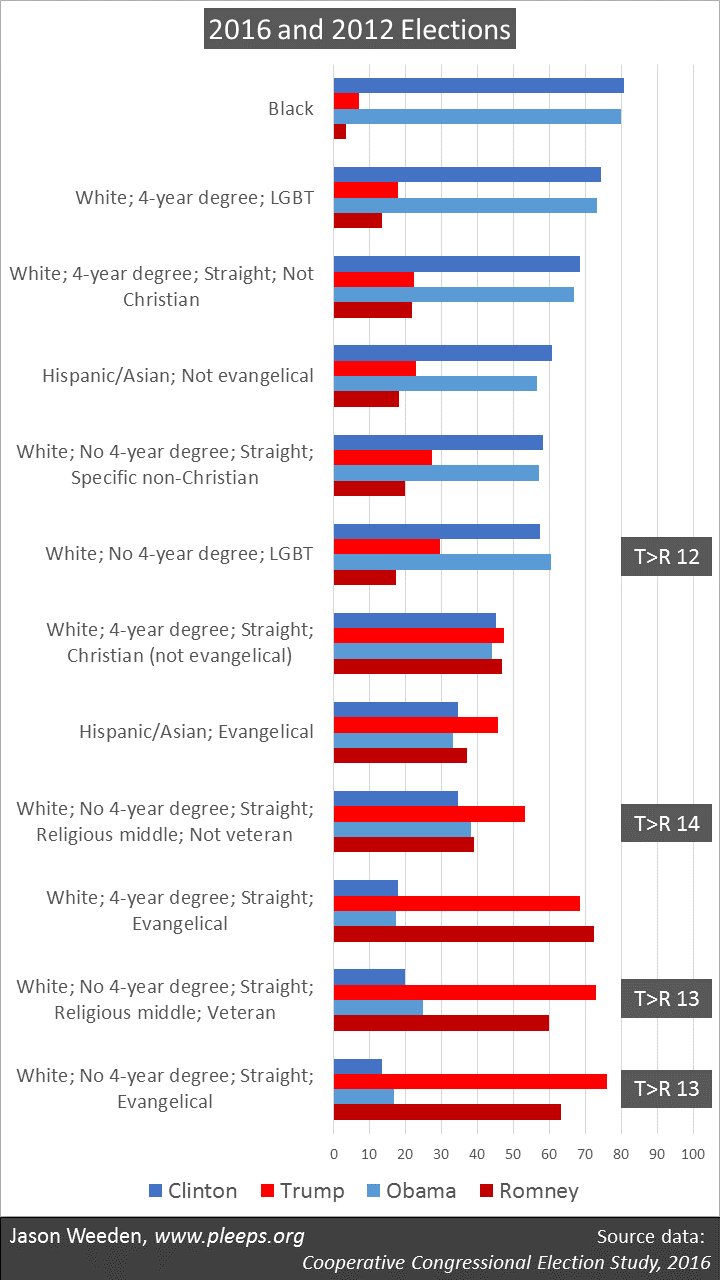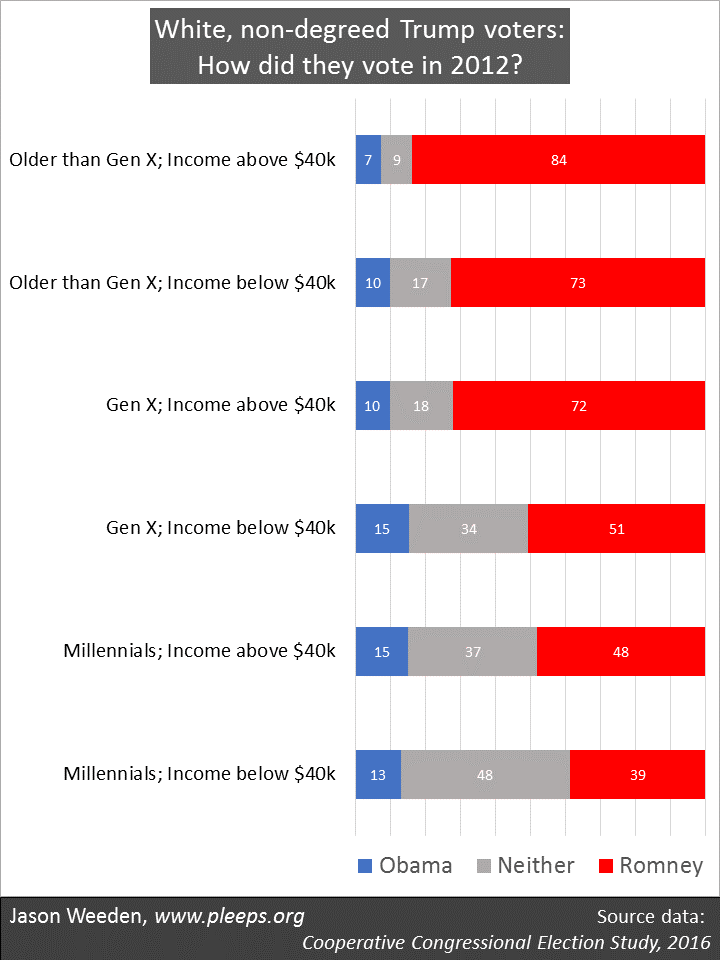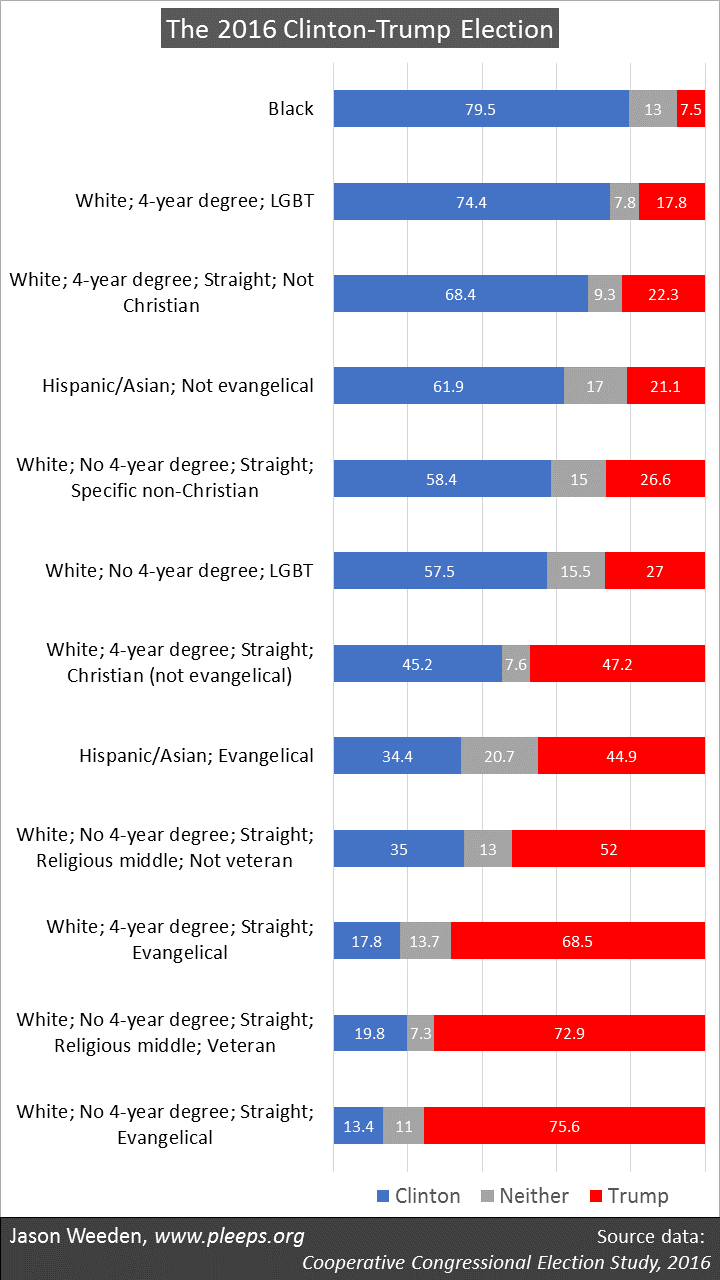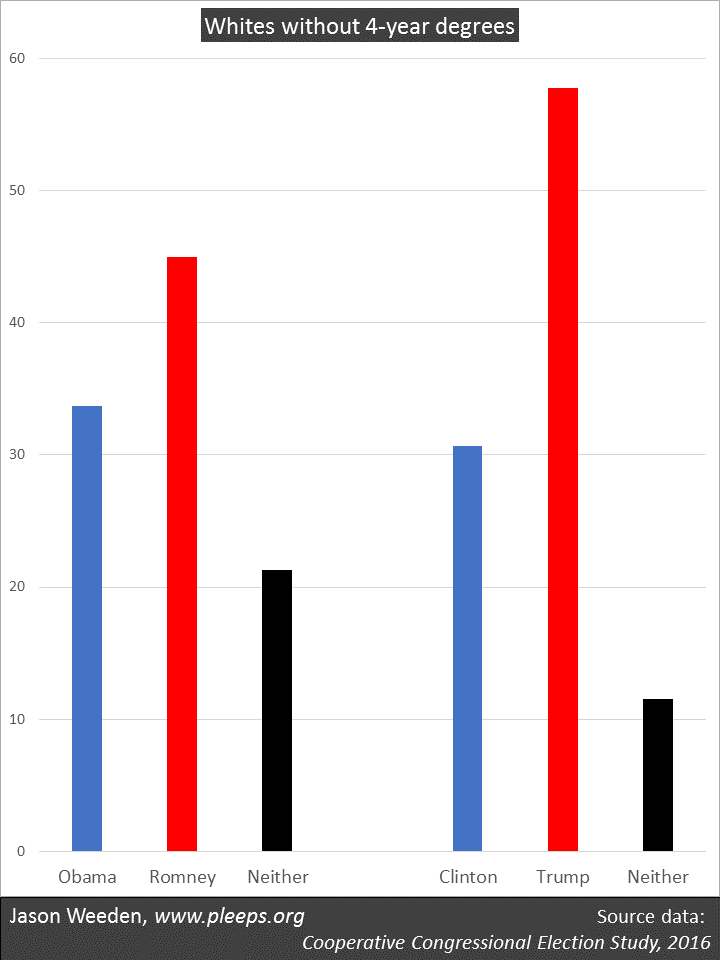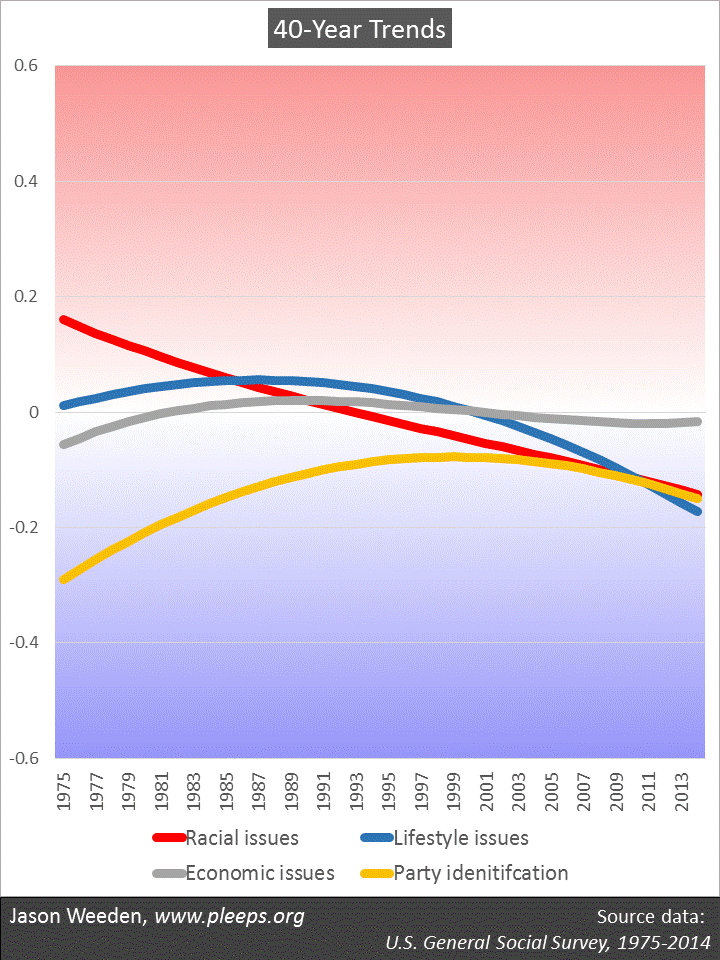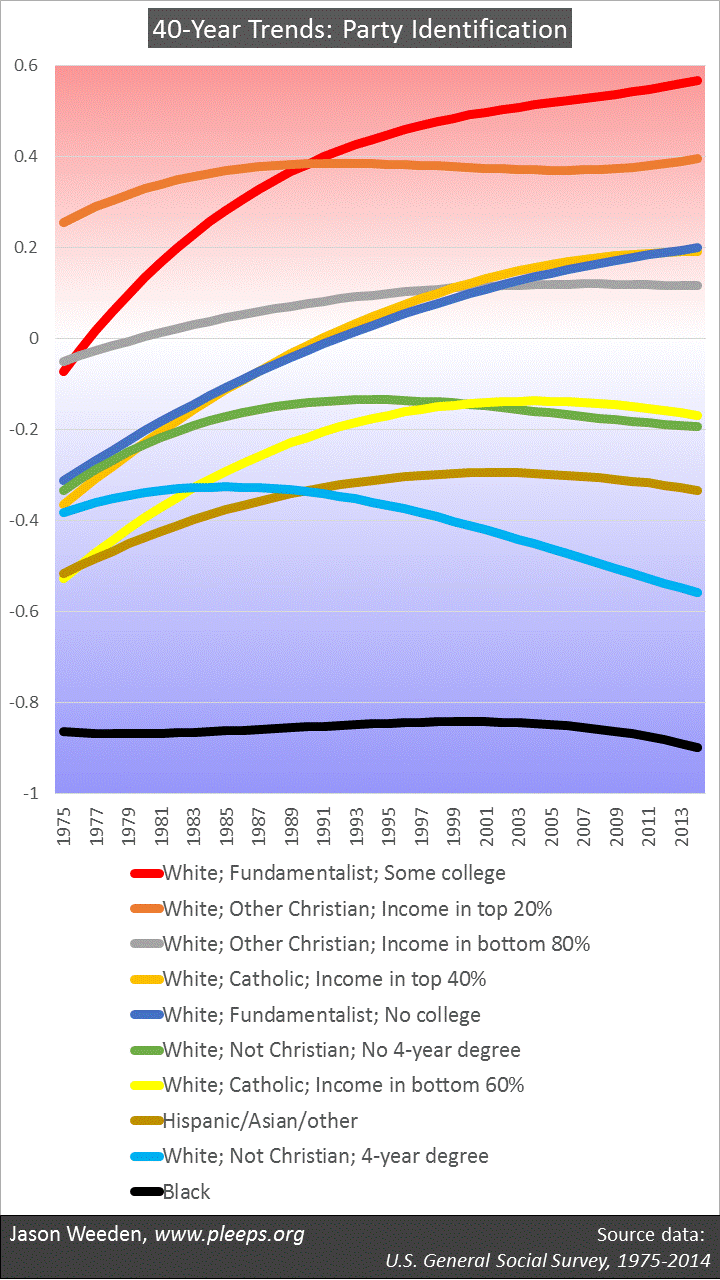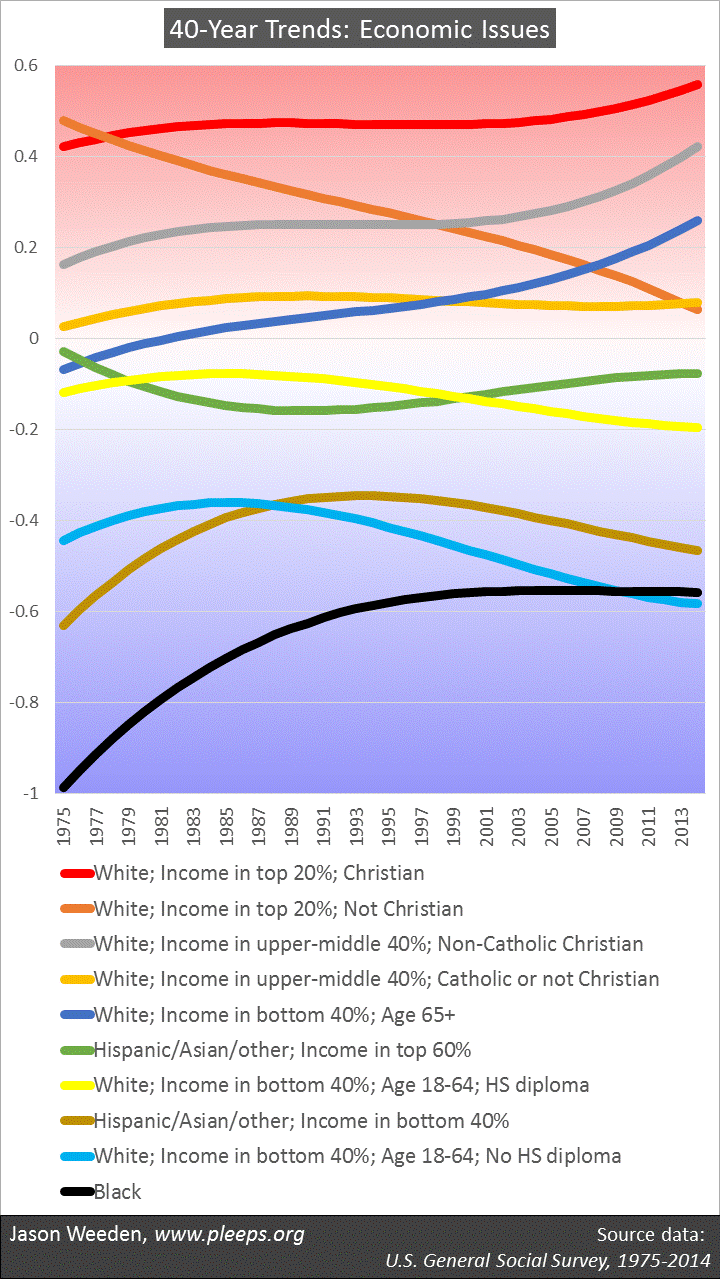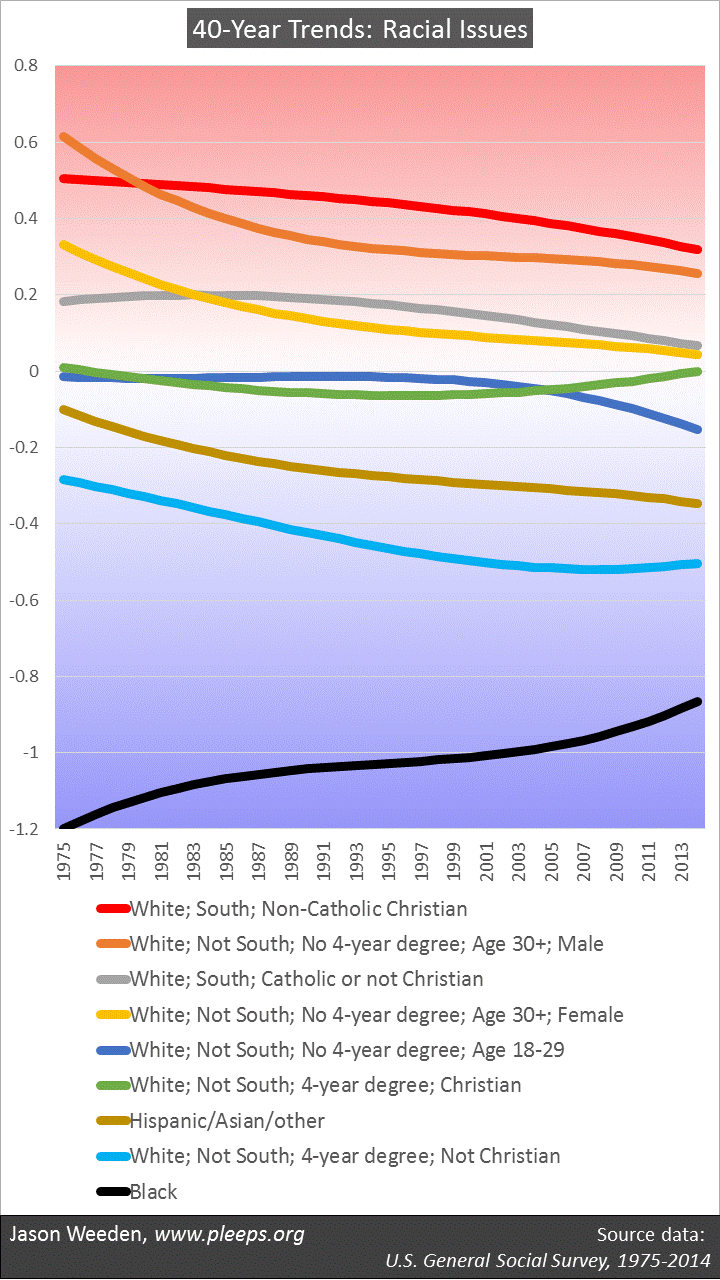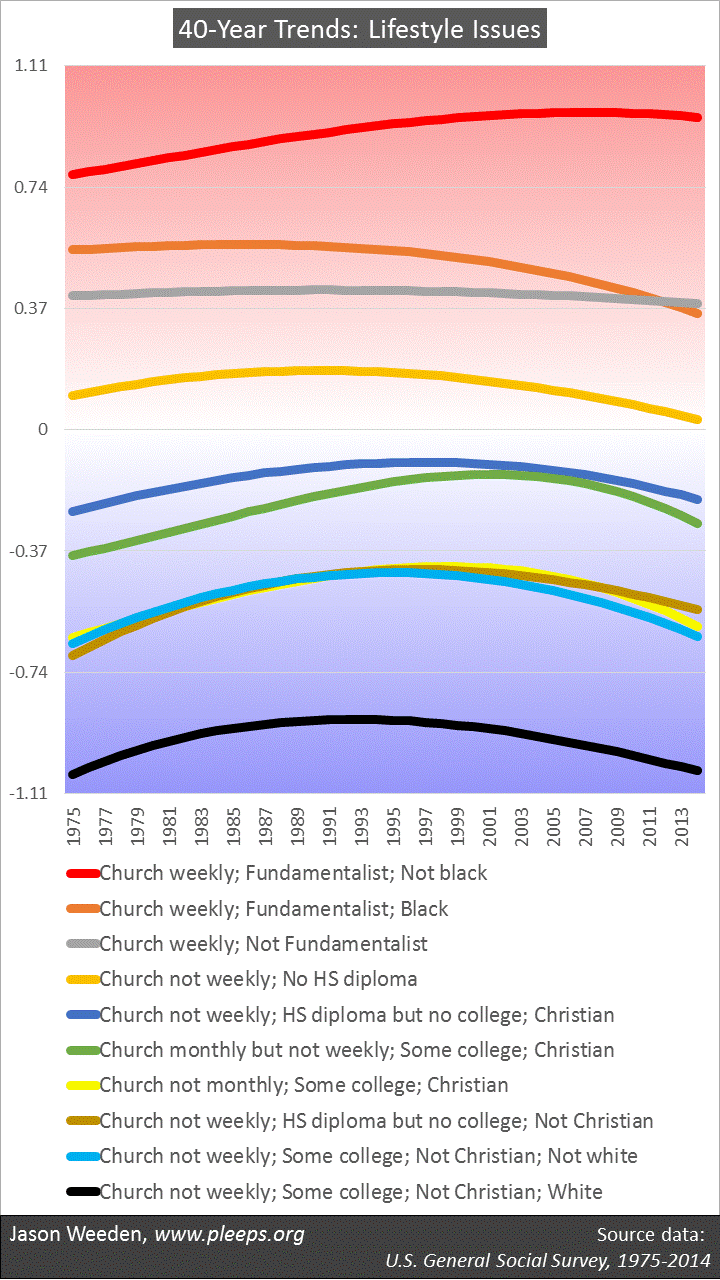People whose issue opinions cluster into relatively consistent liberal or conservative bundles tend to be better educated, white, older, and richer.
It’s one thing to ask about the features that tend to divide liberals and conservatives. Religion and sexual orientation are big deals here, along with race, education, church attendance, military service, gender, income, and so on (see, e.g., here and here).
It’s another thing to ask about ideological consistency. When surveys solicit opinions on a number of different kinds of issues—on abortion, income redistribution, immigration, the military, same-sex marriage, the size of government, race, the environment, guns, and so on—some people are pretty thoroughly either liberal or conservative, where the large majority of their issue positions line up on the same side. But then some people pretty thoroughly mix-and-match their issue opinions, choosing about as many liberal positions as conservative ones.
The tendency to hold issue opinions that are ideologically clustered (or not) has its own set of demographic predictors. When we looked at General Social Survey data (in our book and an article), Kurzban and I identified a big divide between whites with college degrees and everyone else. Across different political issues, whites with college degrees have lots of the most consistently liberal folks as well as lots of the most consistently conservative folks.
The recent 2016 Cooperative Congressional Election Study (CCES) presents a good opportunity to dig deeper here. It’s really big, with over 64,000 respondents who were asked a nice range of different issue opinions. The downside is that it’s an online study, which self-selects a more sophisticated sample, thus overestimating things like political engagement and ideological consistency. But while the baseline might be off somewhat, we can still see what sorts of features tend to distinguish between the ideologues and the mixers-and-matchers.
Basically, I took my CCES ideology scale, which combines 10 different issue positions (on abortion, guns, the minimum wage, immigration, and so on), and instead of looking for what predicts liberals vs. conservatives, I looked for what predicts ideological consistency vs. inconsistency. I examined a broad range of available demographics and the big splits are shown in the chart below.
My results report two things. One is a basic breakdown on ideological consistency, where I’m using Pew’s definitions for what counts as “consistent” (i.e., people whose issue preferences almost all line up in the same direction), “mixed” (i.e., people whose issue preferences are pretty close to equally divided), and “mostly” (i.e., people in between “consistent” and “mixed”). The second thing I show is the percentage of variance that a single factor accounts for in a factor analysis of the 10 issue items within the given group. Don’t worry if you don’t know what that means—just understand that a bigger number here means a higher degree of ideological consistency.
The CCES sample confirms the big roles of education and race in ideological consistency, but suggests some other details as well. One is that, within college-educated whites, Millennials are substantially less likely to be left-right ideologues. This could say something about Millennials in particular, but, more likely, it’s probably a general effect of age. That is, I imagine that if I looked at a big sample from the mid-1990s, where now it’s the Gen Xers who are the younglings, we would see similar patterns of reduced ideological consistency. Or, to put it another way: Just wait—as they age, it’s likely that educated, white Millennials will come to match the ideological consistency of educated, white older folks.
Another detail is that, among the non-college folks, income shows up as a major secondary factor—here, those with lower incomes are less ideologically consistent than those with higher incomes. This overlaps, of course, with both race and education.
The overall differences here are large. Among non-Millennial whites with 4-year degrees in the CCES sample, around 50% are consistent ideologues. But among people who’ve never been to college and who have household incomes below $40,000, only around 17% are consistent ideologues. Among not-so-poor people who’ve never been to college as well as non-whites with at least some college, only around 25% are consistent ideologues. (And, again, all these numbers are inflated relative to the population as a whole, given the skew in online samples.)
Ideology and demographics
I’ve pointed out the big overlap among items such as demographics, identities, ideology, partisanship, issue opinions, and interests. For example, while some political scientists have argued that the electorate is driven by social identities rather than by ideology or issue opinions, it actually doesn’t make much sense to draw such distinctions too starkly.
Along these lines, we’ve just seen that some groups are more likely to hold ideologically clustered opinions than are other groups. In other words, left-right ideology is a bigger deal for some groups. Does this mean that social identities are less relevant for these groups? Not at all. In fact, in an important sense, the more ideological a group, the more relevant some basic demographics become in predicting their politics.
I show a bit of this in the chart below. Here, I’ve taken the six groups from the prior chart—groups that run from most ideologically consistent up top to least down below. Within these groups, I looked at how some of the big-deal demographics—religion, church attendance, sexual orientation, military service, and gender—predict their liberal vs. conservative leanings (using my 10-issue CCES ideology scale).
The question here is: Within these groups, how big of a difference do these demographics make in dividing liberals from conservatives? The clear overall pattern is that, in general, and especially with regard to religion, demographics are more predictive of issue opinions among more ideologically consistent groups than among less ideologically consistent groups. For instance, on my 10-point scale, non-Christians are around 4.7 points to the left of churchgoing evangelicals when we look within the most ideological group (i.e., non-Millennial whites with 4-year degrees), but non-Christians are only around 1.9 points to the left of churchgoing evangelicals when we look within the least ideological group (i.e., people who haven’t been to college and have incomes below $40,000).
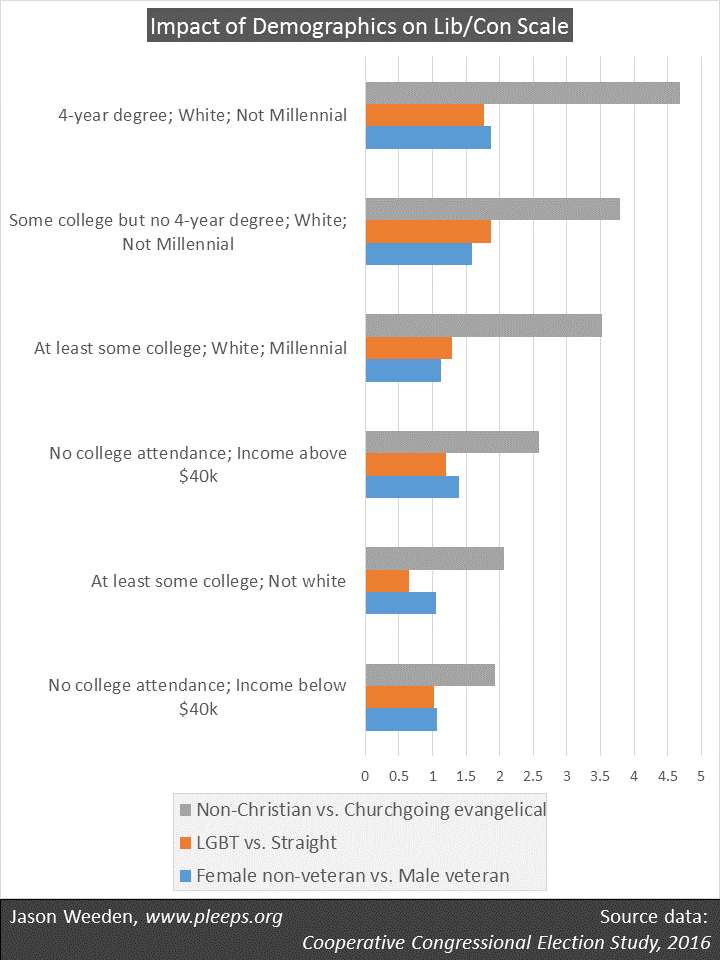 (Note for nerds: The chart above reports OLS regression estimates from models where these demographics are simultaneously predicting my 10-point CCES ideology scale.)
(Note for nerds: The chart above reports OLS regression estimates from models where these demographics are simultaneously predicting my 10-point CCES ideology scale.)
Put another way, when you know their religion, sexual orientation, military service, and gender, it’s actually a lot easier to predict the various issue opinions of college-educated whites than those of other folks. Increased ideological tendencies actually make key social identities more (not less) relevant. So you shouldn’t view ideology and social identities as competing explanations here—again, there’s a big overlap.


